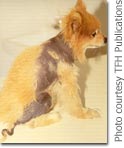| |  The skin and coat of a dog may sometimes change color or become lighter or darker. This may be a normal process, or may be due to a serious disease. If the skin or coat has a color other than white, it is said to be 'pigmented'. Colors include brown, black, red, purple and yellow. If the skin is a darker color than normal it is said to be 'hyperpigmented'. The skin and coat of a dog may sometimes change color or become lighter or darker. This may be a normal process, or may be due to a serious disease. If the skin or coat has a color other than white, it is said to be 'pigmented'. Colors include brown, black, red, purple and yellow. If the skin is a darker color than normal it is said to be 'hyperpigmented'. The table below provides a list of the majority of the conditions which are associated with pigment change. This extensive listing helps you understand why a quick diagnosis may be difficult to make and various diagnostic tests may need to be performed. The most common conditions causing pigment or color changes are color-coded grey in the table (some may be more common in certain geographical areas).
|
 Free Forum Hosting
Free Forum Hosting